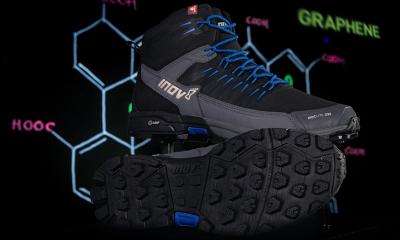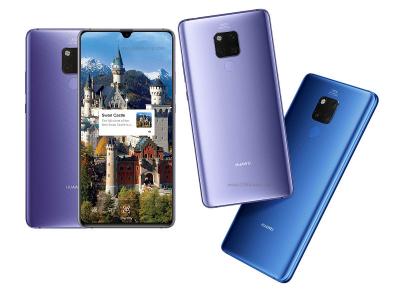The Graphene-Info Newsletter, January 2019
Published: Thu, 01/03/19
University of Manchester and Inov-8 launch graphene-enhanced hiking boots
The collaboration between the University of Manchester and British sportswear brand Inov-8, which started in 2017 and has already produced the G-Series range of graphene-enhanced shoes, has now also resulted in a pair of hiking boots which utilize graphene.
Building on the above-mentioned use of graphene in trail running and fitness shoes last summer, Inov-8 is now bringing the technology to a market it considers to have been "starved of innovation". Two ROCLITE boots with graphene-enhanced rubber grip have been produced – the ROCLITE 335 and the ROCLITE 345 GTX. The former offers increased warmth on cold days, while the latter has waterproof GORE-TEX protection for hiking adventures in wet conditions.
XG Sciences' CEO updates us on the company's latest graphene materials, customers and future plans
US-based graphene developer XG Sciences recently made headlines with a production expansion announcement - and an exciting deal with Ford to supply it with graphene-enhanced parts for the latest the Mustang and F-150 automobiles.
Graphene-Info reached out to XGS' CEO, Philip Rose, who was kind enough to answer a few questions we had regarding the company's latest materials, plans and business. Read the interview here.
Mitsubishi Electric is developing graphene-based super-wideband image sensor
The Advanced Technology R&D Center of Mitsubishi Electric Corp. is reportedly developing a graphene-enhanced image sensor that can sense a wide frequency band of light from visible light to terahertz waves with one device. It is said to be a multi-spectrum image sensor with a lower cost and higher performance, compared with existing multi-spectrum image sensors.
The Advanced Technology R&D Center expects that the graphene-based sensor will replace all kinds of far-infrared sensors because of multiple excellent properties in the future. Though carbon, which is not used for common CMOS processes, is used for the production of the sensor, the manufacturing process of the sensor itself is a commonly-used process.
The filtering for taking in only light with a specific wavelength can be structurally realized without using an optical method, according to the Advanced Technology R&D Center. Specifically, a bandgap is artificially generated by making graphene have a regular pattern so that the sensor becomes sensitive only to desired wavelengths. Also, there is a method of forming a resonance structure so that the sensor becomes highly sensitive only to lights having specific wavelengths corresponding to resonance frequencies.
Huawei starts shipping the Mate 20 X smartphone with its graphene film cooling technology
In October 2018, Huawei announced its Mate 20 X smartphone, which is a large gaming smartphone that adopts a “graphene film cooling technology” for heat management purposes. Huawei now started shipping the Mate 20 X in China and it can be bought in the US starting at $940 (note: affiliate link to Amazon). The graphene producer for this Huawei phone is China-based The Sixth Element Materials.
Huawei states that its Mate 20 X features Huawei Supercool - "the world’s first liquid multi-dimensional cooling system with Vapor Chamber (VC) and Graphene Film used in smartphones". It reportedly conducts heat away fast, keeping the device cool even under heavy loads (as the device is touted as a gaming device).
Army research shows how graphene oxide can help improve munitions
Researchers from the U.S. Army, in collaboration with RDECOM Research Laboratory, the Army's corporate research laboratory (ARL), Stanford University, MIT, University of Southern California and Argonne National Laboratory, discovered a way to get more energy out of energetic materials containing aluminum, common in battlefield systems, by igniting aluminum micron powders coated with graphene oxide. This research could lead to enhanced energetic performance of metal powders as propellant/explosive ingredients in Army's munitions.
This discovery makes use of graphene oxide as an effective light-weight additive for practical energetic applications using micron-size aluminum powders (µAl), i.e., aluminum particles one millionth of a meter in diameter.
Log 9 Materials displays a car that can run on water and air, thanks to a graphene-enhanced battery
Log 9 Materials, an IIT Roorkee spin-off that focuses on graphene material production and application development, recently exhibited a car named Ranger that runs on air and water at India-UK Future Tech event in India.
Log 9 Materials reportedly developed a metal-air battery made up of aluminum and water, which will make the electric vehicles reduce the burden of charging and petrol prices. The graphene-enhanced battery would only require the users to change aluminum from the battery after every 1000kms.
The Metal-air Battery by Log 9 Materials is said to be powered by water, air and metal. This battery is a primary energy generation technology quite similar to a fuel cell. Log 9 is using Graphene to make the batteries commercially viable and economical. If one takes the example of an EV, the car has a range of 100-150 kms after which it has to be charged, which in itself takes up to 5-6 hours. Whereas this battery technology has 10x more energy density which will provide a range of more than 1000 km, after which the metal can be replaced within minutes. The energy generated is completely clean, zero emission and this is a truly environmentally friendly battery technology built with sustainable raw materials. The metal itself is recyclable once it has been used in the battery to generate energy.
The best of 2018 - top graphene stories
2018 will soon be over - and it was a good year for the graphene industry. Graphene-based products are entering the market, and new advances in many applications have been reported. It seems that graphene is finally starting to fulfill its promise.
Here are the top 10 stories posted on Graphene-Info in 2018, ranked by popularity (i.e. how many people read the story):
- On Nanotech Engineering's 92% efficiency graphene-CNTs solar panel claim (Jan 15)
- New graphene-based 'atomristors' could pave the way towards more powerful computing (Jan 19)
- Haydale and WCPC awarded contract to develop advanced wearable technology for athletes training for the 2020 Olympic Games (Sep 20)
- Graphene-enhanced sodium-ion batteries show promise as cheap, effective lithium alternative (Feb 11)
- Australian CSIRO develops promising graphene-based water filtration membrane (Feb 15)
- Ghostek launches the world's first headphones with graphene drivers (Jan 1)
- Callaway launches new graphene-enhanced golf balls (Jan 23)
- First Graphene provides updates on the BEST Battery project (Feb 21)
- Graphene-based heating devices hit the market (Feb 19)
- University of Arkansas aims to commercialize its revolutionary graphene-based VEH technology (Jan 23)
In previous years we've seen that most of our popular stories involved energy applications. In 2018, however, we see a wide range of graphene applications: composites, sports equipment, thermal applications, audio - and of course energy applications.
We hope that 2019 will offer continued growth, more applications and increased adoption of graphene in a wider range of industries.
Versarien announced its plans to enter an agreement with a large state-owned Chinese aerospace company.
An international research team found a new mechanism for highly-efficient charge and energy flow in graphene, opening the door to new types of light-harvesting devices.
NanoXplore announced its plans for a private placement for gross proceeds of approximately CAD$30 million (around USD $22.3 million) and also announced that entering into an updated Memorandum of Understanding with Martinrea International.
Haydale Graphene Industries is to partner with Wheelsure Holdings to work on a graphene pressure sensor.
Researchers from the University of Vienna and international scientists developed a new nanostructured anode material for lithium ion batteries, which extends the capacity and cycle life of the batteries, using a mesoporous mixed metal oxide in combination with graphene.
The Graphene Innovation center, a £60 million world-class center dedicated to researching graphene and its applications, has been opened in Manchester, UK.
Don’t miss the new article on graphene and CNTs - similarities, differences, applications and status.
Researchers from the University of Strasbourg & CNRS (France), in collaboration with Adam Mickiewicz University in Poznań (Poland) and the University of Florence (Italy), developed a new generation of pressure sensors based on graphene and molecular “springs”.
Researchers at Royal Melbourne Institute of Technology (RMIT) have found that graphene could better fulfill its potential when purified to remove silicon, doubling its electrical performance.
Graphene Flagship partners Aernnova, Grupo Antolin-Ingenieria and Airbus have produced a leading edge for the Airbus A350 horizontal tail plane using graphene-enhanced composites
Scientists from The University of Manchester have combined graphene with the natural fiber jute, to create graphene-strengthened natural jute fiber composites.
In a guest post by Guillaume Chansin, the status, potential and forward outlook of graphene applications are discussed.
Do you have a friend or a colleague that might be interested in Graphene technology? Forward this mail to update him on the world of Graphene.
If you received this email from a friend, subscribe to this newsletter here!








